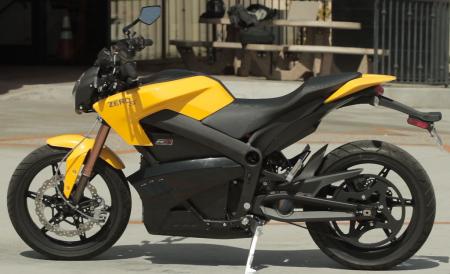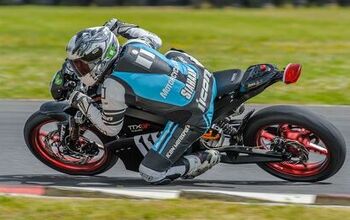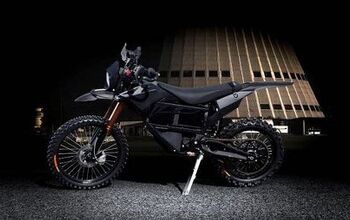2013 Zero S Review - Motorcycle.com
If you’re not yet weary of reading about how electric motorcycles have been approaching the speed and usability of petrol-powered bikes, here’s another chance. The new 2013 Zero S is changing the way we judge these electron-excited two-wheelers.
Last week we wrote about Honda’s redesigned CBR600RR in this review. The most notable changes from its 2007 debut are a new fork and restyled bodywork, retaining the same major components for six years running – and likely for a few more.
Meanwhile, the pace of development at Zero has been furious, perhaps more so than any OEM in motorcycle history. Its 2012 models were a fair leap forward in technology and execution, and now, less than a year later, comes another comprehensive revamp, with extended ranges and bigger power outputs from a new motor.
COMPETITION: Read our review of the 2013 Brammo Empulse R
The sporty Zero S tested here and dual-purpose DS get their own particular upgrades, including redesigned aluminum frames, many cosmetic enhancements, improved finish quality and higher-spec components. And it’s now even handier for running errands thanks to a zippered storage compartment in its faux fuel tank. Also new are standard passenger accommodations, including grab handles integrated into the tailsection.
At the heart of the S is a new air-cooled brushless electric motor that is proprietary to Zero. The Z-Force direct-drive motor is purported to nearly double the available horsepower of the previous electron muncher. There’s a claimed 54 horses on tap and a more impressive 68 ft-lb torque figure (a 62% boost), enough to motivate the 382-lb machine to traffic-beating acceleration levels that are exciting even for those of us who get to ride the fastest bikes in the land. For reference, the S weighs within just a few pounds of Kawasaki’s entertaining Ninja 300, a sportbike that transmits just 35 ponies to the rear tire and a relatively paltry peak of 18 ft-lb of torque.
The powertrain’s “fuel” source is also upgraded for 2013. Last year an owner had the choice of a 6.0- or a 9.0-Kilowatt-Hour battery pack. For 2013, the standard pack is uprated to 8.5 KwH, while a new 11.4 KwH system adds $2000 to the S’s $13,995 base price along with a 20% boost in range.
By the way, battery capacity ratings are in a state of flux. The numbers presented above are the battery’s maximum rating, a figure that can’t really be achieved in real-world use. More accurate are nominal ratings (7.5 and 10.0 KwH in the Zero), which are on their way to becoming the de facto standard as e-vehicles evolve.
The Zero’s on-board charger operates at 1.3 KwH, which translates to a charge-from-empty time via a 110-volt outlet of 6.0 hours for the standard batt pack; 7.9 hours for the bigger one. Zero claims the new bikes have a 25% quicker charging rates than last year and cost only about $1 of electricity for a full charge. The e-bike company also has a charge trick up its sleeve. Either battery pack can be charged to 95% capacity in one hour at a CHAdeMO charge station via an optional charger. Unfortunately, those high-tech charging stations are thus far quite rare.
The higher-wattage 2013 batteries deliver some impressive range ratings under the EPA’s UDDS (urban dynamometer drive schedule) standards of testing. With the 11.4-KwH battery, it’s rated at a vast 137-mile range in low-speed (20 mph average) urban use. Naturally, that lofty number is impossible to beat in fast-flowing traffic or during any freeway use. Its rated range drops to 70 miles at a steady 70-mph cruise.
VIEW: The State of Zero Motorcycles
An Electric Riding Experience
The new Zero S, along with the recently reviewed Brammo Empulse, has raised the bar in what’s possible from an electric-powered motorcycle. No longer just adequately quick, the Zero S is now downright zippy and able to outrun any normal traffic without breaking an electron sweat. The Zero demands little from its rider – no clutch and no shifting gears, just twist and go. It’s docile enough to suit newer riders, especially in Eco mode, yet sprightly enough to keep experienced riders entertained, especially in Sport mode.
Off-the-line acceleration of every e-bike is limited by the programming of its motor controller, universally restricting the initial hit to not startle its operator and to moderate the amount of draw on the batteries. The S is no different, and it’s easy to notice the clutch-slipping-like feel while accelerating from a stop. We know it’s limited because the S accelerates harder at 20 mph than it does at 1 mph.
More stunning is the S’s highway passing power. It blasts from 70 to 80 mph almost instantly, offering acceleration that rivals many ICE motorcycles. It feels composed and understressed even at an indicated 85 mph, although those sorts of velocities will rapidly drain the lithium-ion batteries.
The Zero S works best in an urban environment because its range increases the slower you go. And it’s a distinctive pleasure when sitting at a stoplight and knowing there’s not a penny’s worth of fuel being burned. Weighing less than most motorcycles, it’s very easy to manage, aided by a reasonably low 31.3-inch seat height and comfortably upright ergonomics. Its size feels tidy yet uncramped.
I really enjoyed the S’s simple jump-on-and-ride character, never hesitating to mount it for even the tiniest of trips. Expanding its errand-running capability is a new storage compartment located in a cavity inside the faux fuel tank that proves to be remarkably handy, able to conveniently swallow smallish items like fast food or a few dozen candy bars. Its lid is sealed by a zipper that can be secured with a small padlock, but it’s not as impervious to thieves as a hinged plastic cover like that of Honda’s innovative NC700X.
Instrumentation is surprisingly simple for such a tech-rich vehicle. What would normally be a shift light atop the instrument cluster is actually a run light to show a rider the bike is primed and ready to go when the throttle is twisted. The cluster is dominated by a 7000-rpm analog tach that is mostly superfluous, as there’s no shifting possible, let alone required. It consumes space for other instrumentation that relies almost exclusively on a relatively small LCD info screen that shows speed, battery level and odometers.
However, Zero has cooked up a pioneering augmentation to the stock instruments: your smartphone. An optional mount secures phones with Android or Apple operating systems above the triple clamp and can be paired to the bike via a Bluetooth connection, greatly expanding the instrumentation capabilities to include range calculations, current level of power supplied and, most intriguing, controls for altering the amount of deceleration provided when the throttle is closed.
One of the most difficult areas to get right on an e-bike is its power delivery and its behavior when the throttle is closed. Zero has done an excellent job of tuning of its “throttle” (an electric bike technically doesn’t have a throttle) response when applying power, enabling smooth inputs at all times. But the amount of deceleration of e-bikes is more difficult to tune because individual riders prefer different settings. As delivered, there’s little to gripe about in this respect, with more regenerative braking in Eco mode than Sport, but it’s a real treat to be able to customize the response by punching a few buttons on an iPhone.
Otherwise, the Zero S is a fairly simple machine, especially in regard to maintenance – there basically isn’t any, not even to lube a chain thanks to a carbon fiber-infused drive belt. Fret not about costly and messy valve adjustments or oil changes.
RESEARCH: All Things Electric on Motorcycle.com
Brakes are new Nissin units with wave rotors, and they offer a very firm lever through braided steel lines and strong speed retardation for the bike’s typical speeds, even if feedback isn’t quite up to the level of Brembo monoblocs. The rear brake pedal is positioned a little too high and inboard for swift and easy access.
Suspension action is significantly improved for 2013 with new components from Fast Ace, a Taiwanese suspension company. The front is supported by a 38mm inverted fork that features adjustable compression and rebound damping. The shock also boasts damping amendments as well as preload adjustability.
The Zero S’s capabilities on a twisty road are limited more by the proximity of said road than any deficiency of the bike, as most canyon roads are situated miles from where most people live. But when you’re on a serpentine path, you’ll appreciate the S’s light steering and nimble feel, as well as its fairly robust power output. The main impediment to embarrassing a sportbike rider is its somewhat limited lean angle ability – it runs out of ground clearance before the narrow (110/70F; 130-70R) 17-inch bias-ply IRC tires run out of grip. Firming up the suspension delivers greater lean angles before the pegs start dragging.
The only noise the Zero emits is a faint whistle/whine as it breathlessly whisks you along. Personally, I’d like it if it was a little louder. It would not only create a more involving ride for the pilot (and, perhaps, pedestrians), but it might even be marginally safer because the extra sound would make it more conspicuous.
The Not So Good
If it hasn’t been obvious by now, we really like the 2013 Zero S. But we’d love it more if a few details were addressed. For one, its aluminum sidestand appears massively overbuilt and is slightly too long. Sure, it looks impressive, but a shorter and less robust piece would work better and be lighter.
Also, the Zero’s mirrors are nicely stylish, but lane-splitting Californians would appreciate if they resided inboard of the handlebar’s ends, as the driver of a ratty Camry found out when I boinked his mirror. They protrude 5 inches beyond the bars on each side, adding up to 10 inches of extra width. The mirrors would be blocked by a rider’s forearms if moved inboard on their stock mounts, so the solution would be narrower arms on a higher perch.
Conclusion
Range anxiety is the largest impediment to any battery-powered vehicle. Although Zero has made enormous strides in terms of range, there remains a palpable leash that restricts the e-bike to trips of less than 80 miles or so, depending on how and where you’re riding. We were pleased to see a drop of just three bars (less than one-third) of battery power after a spirited 20-mile jaunt at speeds up to 55 mph.
But ridden like a typical MOron on Latigo Canyon and up to 65 mph on faster portions of PCH, plus a half-dozen freeway miles of higher-speed acceleration testing, the high-capacity Zero S ran out of electron steam completely after 62 miles. This type of abuse is, to say the least, atypical use for an e-bike, so it’s not representative of what riders can expect in normal around-town conditions where we’d expect 80 miles of range when charging through traffic.
When used within its limitations, the Zero S is a great ride. And for most Americans, their daily commute is within range of the Zero’s capabilities, especially if freeway travel is minimal. For these riders, the Zero is a pleasantly satisfying maintenance- and fuel-free ride. Even more so if your travels take you in the vicinity of a CHAdeMO charge station.
The 2013 Zero S up the ante to and past sprightly levels of acceleration, able to jump ahead of nearly any vehicle with just a simple twist of the wrist. And for the noobs out there who’d be interested in a easy to use motorcycle, the Zero would be a novel and interesting introduction to two wheels. Conservative riders will really appreciate its simple and relatively docile nature.
However, any prospective owner will have to deal with the hurdle of a $14K base price, minus any state and federal tax incentives that can reduce the price by thousands. And it would be difficult not to opt for the extended leash offered by the $16K version with the larger battery. But after vaulting over the price barrier, an owner is looking at spending just pennies a day on fuel. Warrantee coverage lasts two years.
For a motorcyclist like myself with decades of riding experience behind me, I’m fascinated by the frequent march of progress exhibited by ever-developing technology. And in that respect, e-bikes are more interesting than the ICE bikes we’ve loved for lifetimes.
More by Kevin Duke








































Comments
Join the conversation